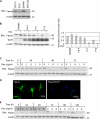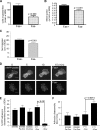Dual actin-bundling and protein kinase C-binding activities of fascin regulate carcinoma cell migration downstream of Rac and contribute to metastasis
- PMID: 17855511
- PMCID: PMC2043557
- DOI: 10.1091/mbc.e07-02-0157
Dual actin-bundling and protein kinase C-binding activities of fascin regulate carcinoma cell migration downstream of Rac and contribute to metastasis
Abstract
Recurrence of carcinomas due to cells that migrate away from the primary tumor is a major problem in cancer treatment. Immunohistochemical analyses of human carcinomas have consistently correlated up-regulation of the actin-bundling protein fascin with a clinically aggressive phenotype and poor prognosis. To understand the functional and mechanistic contributions of fascin, we undertook inducible short hairpin RNA (shRNA) knockdown of fascin in human colon carcinoma cells derived from an aggressive primary tumor. Fascin-depletion led to decreased numbers of filopodia and altered morphology of cell protrusions, decreased Rac-dependent migration on laminin, decreased turnover of focal adhesions, and, in vivo, decreased xenograft tumor development and metastasis. cDNA rescue of fascin shRNA-knockdown cells with wild-type green fluorescent protein-fascin or fascins mutated at the protein kinase C (PKC) phosphorylation site revealed that both the actin-bundling and active PKC-binding activities of fascin are required for the organization of filopodial protrusions, Rac-dependent migration, and tumor metastasis. Thus, fascin contributes to carcinoma migration and metastasis through dual pathways that impact on multiple subcellular structures needed for cell migration.
Figures






Similar articles
-
Rac regulates the interaction of fascin with protein kinase C in cell migration.J Cell Sci. 2008 Sep 1;121(Pt 17):2805-13. doi: 10.1242/jcs.022509. J Cell Sci. 2008. PMID: 18716283
-
A novel Rho-dependent pathway that drives interaction of fascin-1 with p-Lin-11/Isl-1/Mec-3 kinase (LIMK) 1/2 to promote fascin-1/actin binding and filopodia stability.BMC Biol. 2012 Aug 10;10:72. doi: 10.1186/1741-7007-10-72. BMC Biol. 2012. PMID: 22883572 Free PMC article.
-
Stimulation of fascin spikes by thrombospondin-1 is mediated by the GTPases Rac and Cdc42.J Cell Biol. 2000 Aug 21;150(4):807-22. doi: 10.1083/jcb.150.4.807. J Cell Biol. 2000. PMID: 10953005 Free PMC article.
-
How does fascin promote cancer metastasis?FEBS J. 2021 Mar;288(5):1434-1446. doi: 10.1111/febs.15484. Epub 2020 Jul 23. FEBS J. 2021. PMID: 32657526 Free PMC article. Review.
-
Fascin: a key regulator of cytoskeletal dynamics.Int J Biochem Cell Biol. 2010 Oct;42(10):1614-7. doi: 10.1016/j.biocel.2010.06.019. Epub 2010 Jun 30. Int J Biochem Cell Biol. 2010. PMID: 20601080 Review.
Cited by
-
BRAF and RAS oncogenes regulate Rho GTPase pathways to mediate migration and invasion properties in human colon cancer cells: a comparative study.Mol Cancer. 2011 Sep 23;10:118. doi: 10.1186/1476-4598-10-118. Mol Cancer. 2011. PMID: 21943101 Free PMC article.
-
Fascin1 suppresses RIG-I-like receptor signaling and interferon-β production by associating with IκB kinase ϵ (IKKϵ) in colon cancer.J Biol Chem. 2018 Apr 27;293(17):6326-6336. doi: 10.1074/jbc.M117.819201. Epub 2018 Mar 1. J Biol Chem. 2018. PMID: 29496994 Free PMC article.
-
Fascin1 is dispensable for mouse development but is favorable for neonatal survival.Cell Motil Cytoskeleton. 2009 Aug;66(8):524-34. doi: 10.1002/cm.20356. Cell Motil Cytoskeleton. 2009. PMID: 19343791 Free PMC article.
-
Effect of rs67085638 in long non-coding RNA (CCAT1) on colon cancer chemoresistance to paclitaxel through modulating the microRNA-24-3p and FSCN1.J Cell Mol Med. 2021 Apr;25(8):3744-3753. doi: 10.1111/jcmm.16210. Epub 2021 Mar 11. J Cell Mol Med. 2021. PMID: 33709519 Free PMC article.
-
Fascin overexpression promotes neoplastic progression in oral squamous cell carcinoma.BMC Cancer. 2012 Jan 20;12:32. doi: 10.1186/1471-2407-12-32. BMC Cancer. 2012. PMID: 22264292 Free PMC article.
References
-
- Adams J. C. Roles of fascin in cell adhesion and motility. Curr. Opin. Cell Biol. 2004;16:590–596. - PubMed
Publication types
MeSH terms
Substances
Grants and funding
LinkOut - more resources
Full Text Sources
Other Literature Sources
Miscellaneous

